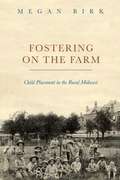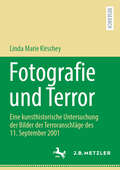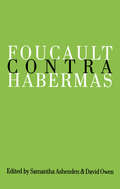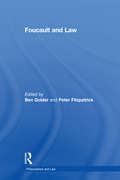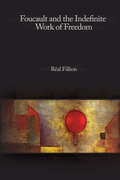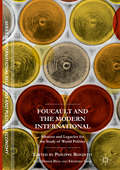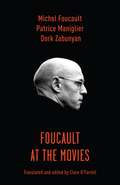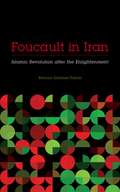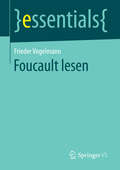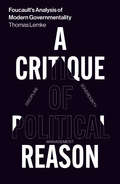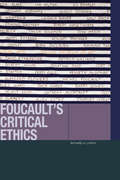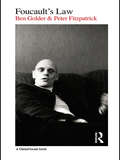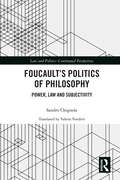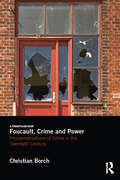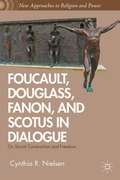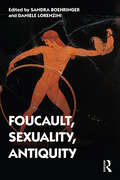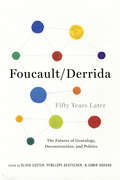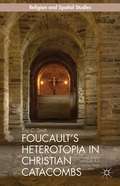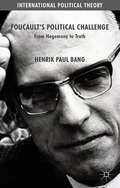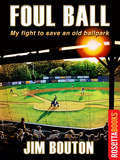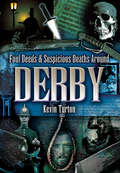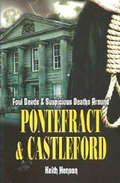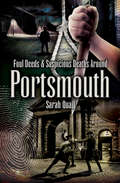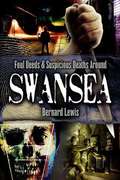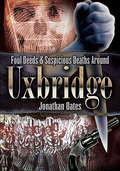- Table View
- List View
Fostering on the Farm: Child Placement in the Rural Midwest
by Megan BirkFrom 1870 until after World War I, reformers led an effort to place children from orphanages, asylums, and children's homes with farming families. The farmers received free labor in return for providing room and board. Reformers, meanwhile, believed children learned lessons in family life, citizenry, and work habits that institutions simply could not provide. Drawing on institution records, correspondence from children and placement families, and state reports, Megan Birk scrutinizes how the farm system developed--and how the children involved may have become some of America's last indentured laborers. Between 1850 and 1900, up to one-third of farm homes contained children from outside the family. Birk reveals how the nostalgia attached to misplaced perceptions about healthy, family-based labor masked the realities of abuse, overwork, and loveless upbringings endemic in the system. She also considers how rural people cared for their own children while being bombarded with dependents from elsewhere. Finally, Birk traces how the ills associated with rural placement eventually forced reformers to transition to a system of paid foster care, adoptions, and family preservation.
Fotografie und Terror: Eine kunsthistorische Untersuchung der Bilder der Terroranschläge des 11. September 2001
by Linda Marie KirscheyBei Fotografien herausragender historischer Ereignisse stellen sich immer bestimmte Bilder heraus, die vornehmlich publiziert und dadurch kollektiv erinnert werden können. Dies verdeutlicht auch die fotografische Präsentation des 11. September. Wenngleich im wissenschaftlichen Diskurs der Terroranschläge von einem Bildereignis und dem meistfotografierten Ereignis der Gegenwart gesprochen wird, so sind es die brennenden Türme, die zum Sinnbild von 9/11 geworden sind. Der öffentliche Bilderkanon an den Folgetagen der Anschläge ist mit stets denselben, symbolisch sortierten Bildern gespeist. Folglich stellt sich die Frage nach alternativen Strategien der Sichtbarkeit, die sich hinter der sogenannten Bilderflut des Ereignisses verbergen. Denn die öffentliche Visualisierung der Terroranschläge verortet sich innerhalb eines zunächst widersprüchlich erscheinenden Spannungsfeldes aus einer Bilderflut repetitiver Motive und einer gleichzeitigen Bilderarmut der Motivvielfalt. Aus kunsthistorischer Perspektive deckt die Studie ein anderes Verständnis für die Fotografie des Terrors auf. Spezifische Topoi differenzieren das fotografische Gesicht dieses Ereignisses aus, um das Bild des Terrors motivisch zu erweitern.
Foucault Contra Habermas: Recasting the Dialogue between Genealogy and Critical Theory (Social Theory Ser.)
by David Owen Samantha AshendenFoucault contra Habermas is an incisive examination of, and a comprehensive introduction to, the debate between Foucault and Habermas over the meaning of enlightenment and modernity. It reprises the key issues in the argument between critical theory and genealogy and is organised around three complementary themes: defining the context of the debate; examining the theoretical and conceptual tools used; and discussing the implications for politics and criticism. In a detailed reply to Habermas' Philosophical Discourse of Modernity, this volume explains the difference between Habermas' philosophical practice and Foucault's between the analytics of truth and the politics of truth. Many of the most difficult arguments in the exchange are subject to a detailed critical analysis. This examination also includes discussion of the ethics of dialogue; the practice of criticism; the politics of recognition , and the function of civil society and democracy.
Foucault and Law: On Law, Power And Rights (Philosophers And Law Ser.)
by Ben Golder Peter FitzpatrickFew thinkers can have had a more diverse or a more contested impact on theorizing law than Michel Foucault. This diversity is reflected in the wide range of Foucault's work and of the intellectual fields it has so conspicuously influenced. Such diversity informs the present collection and is signalled in the headings of its four sections: � Epistemologies: archaeology, discourse, Orientalism � Political philosophy: discipline, governmentality and the genealogy of law � Embodiment, difference, sexuality and the law � The subject of rights and ethics. Whilst the published work selected for this collection amply accommodates this diversity, it also draws together strands in Foucault's work that coalesce in seemingly conflicting theories of law. Yet the editors are also committed to showing how that very conflict goes to constitute for Foucault an integral and radical theory of law. This theory ranges not just beyond the restrained and diminished conceptions of law usually derived from Foucault, but also beyond the characteristic concern in Jurisprudence and Legal Philosophy to constitute law in its difference and separation from other socio-political forms.
Foucault and the Indefinite Work of Freedom (Philosophica)
by Réal FillionThis work underscores the need to examine history philosophically, not only to better appreciate how it unfolds and relates to our own unfolding lives, but to better appreciate our free engagement in this changing world. Linking a conception of ourselves as free beings to the historical process was of central importance to the classical speculative philosophies of history of the nineteenth century, most notably Hegel’s. Michel Foucault’s work is often taken to be the antithesis of this kind of speculative approach. This book argues that Foucault, on the contrary, like Hegel, sees freedom as tied to the self-movement of thought as it realizes and shapes the world. Unlike Hegel, however, he does not see in that self-movement the process of Spirit reconciling itself with the world and thereby realizing itself as freedom. Rather, he sees in the freedom at the core of the self-movement of thought a possible threat around which that movement consolidates itself and gives shape to the world. Foucault’s work is therefore not a simple rejection of Hegel’s speculative philosophy of history, but rather an inversion of the manner in which history and freedom are related: for Hegel history realizes or actualizes the “idea” of freedom, whereas for Foucault freedom realizes or actualizes the “materiality” of history.
Foucault and the Modern International: Silences and Legacies for the Study of World Politics (The Sciences Po Series in International Relations and Political Economy)
by Philippe Bonditti, Didier Bigo and Frédéric GrosThis book addresses the possibilities of analyzing the modern international through the thought of Michel Foucault. The broad range of authors brought together in this volume question four of the most self-evident characteristics of our contemporary world-'international', 'neoliberal', 'biopolitical' and 'global'- and thus fill significant gaps in both international and Foucault studies. The chapters discuss what a Foucauldian perspective does or does not offer for understanding international phenomena while also questioning many appropriations of Foucault's work. This transdisciplinary volume will serve as a reference for both scholars and students of international relations, international political sociology, international political economy, political theory/philosophy and critical theory more generally.
Foucault at the Movies
by Patrice Maniglier Dork ZabunyanMichel Foucault’s work on film, although not extensive, compellingly illustrates the power of bringing his unique vision to bear on the subject and offers valuable insights into other aspects of his thought. Foucault at the Movies brings together all of Foucault’s commentary on film, some of it available for the first time in English, along with important contemporary analysis and further extensions of this work.Patrice Maniglier and Dork Zabunyan situate Foucault’s writings on film in the context of the rest of his work as well as within a broad historical and philosophical framework. They detail how Foucault’s work directly or indirectly inspired both film critics and directors in surprising ways and discuss his ideas in relation to significant movements within film theory and practice. The book includes film reviews and discussions by Foucault as well as his interviews with the prestigious film magazine Cahiers du cinéma and other journals. Also included are his dialogues with the noted French feminist writer Hélène Cixous and film directors Werner Schroeter and René Féret. Throughout, Foucault and those he is in conversation with reflect on the relationship of film to history, the body, power and politics, knowledge, sexuality, aesthetics, and institutions of internment. Foucault at the Movies makes all of Foucault’s writings on film available to an English-speaking audience in one volume and offers detailed, up-to-date commentary, inviting us to go to the movies with Foucault.
Foucault in Iran: Islamic Revolution after the Enlightenment (Muslim International)
by Behrooz Ghamari-TabriziWere the thirteen essays Michel Foucault wrote in 1978–1979 endorsing the Iranian Revolution an aberration of his earlier work or an inevitable pitfall of his stance on Enlightenment rationality, as critics have long alleged? Behrooz Ghamari-Tabrizi argues that the critics are wrong. He declares that Foucault recognized that Iranians were at a threshold and were considering if it were possible to think of dignity, justice, and liberty outside the cognitive maps and principles of the European Enlightenment. Foucault in Iran centers not only on the significance of the great thinker&’s writings on the revolution but also on the profound mark the event left on his later lectures on ethics, spirituality, and fearless speech. Contemporary events since 9/11, the War on Terror, and the Arab Uprisings have made Foucault&’s essays on the Iranian Revolution more relevant than ever. Ghamari-Tabrizi illustrates how Foucault saw in the revolution an instance of his antiteleological philosophy: here was an event that did not fit into the normative progressive discourses of history. What attracted him to the Iranian Revolution was precisely its ambiguity.Theoretically sophisticated and empirically rich, this interdisciplinary work will spark a lively debate in its insistence that what informed Foucault&’s writing was not an effort to understand Islamism but, rather, his conviction that Enlightenment rationality has not closed the gate of unknown possibilities for human societies.
Foucault lesen (essentials)
by Frieder VogelmannDieses essential stellt einen systematischen und philosophischen Lekturevorschlag zur Diskussion: Systematisch werden Foucaults Schriften von seiner methodologischen Perspektive her als nihilistische, nominalistische und historizistische Analyse von Praktiken und den in ihnen produzierten Wirklichkeiten entlang der drei Achsen des Wissens, der Macht und der Selbstverhaltnisse gedeutet. Die Konsequenzen dieser Interpretation werden anhand der Positionen umrissen, die sich in Bezug auf Foucaults Kritikbegriff, seine Attacke auf die Human- und, als Teil davon, die Sozialwissenschaften und sein Verhaltnis zum Neoliberalismus ergeben. Philosophisch ist dieser Lekturevorschlag, weil er die Historisierung von Wahrheit als Kern von Foucaults philosophischem Verfahren behauptet. "
Foucault's Analysis of Modern Governmentality: A Critique of Political Reason
by Thomas LemkeTracking the development of Foucault's key conceptsLemke offers the most comprehensive and systematic account of Michel Foucault's work on power and government from 1970 until his death in 1984. He convincingly argues, using material that has only partly been translated into English, that Foucault's concern with ethics and forms of subjectivation is always already integrated into his political concerns and his analytics of power. The book also shows how the concept of government was taken up in different lines of research in France before it gave rise to "governmentality studies" in the Anglophone world.A Critique of Political Reason provides a clear and well-structured exposition that is theoretically challenging but also accessible for a wider audience. Thus, the book can beread both as an original examination of Foucault's concept of government and as a general introduction to his "genealogy of power".
Foucault's Critical Ethics (Just Ideas)
by Richard A. LynchThe central thesis of Foucault’s Critical Ethics is that Foucault’s account of power does not foreclose the possibility of ethics; on the contrary, it provides a framework within which ethics becomes possible. Tracing the evolution of Foucault’s analysis of power from his early articulations of disciplinary power to his theorizations of biopower and governmentality, Richard A. Lynch shows how Foucault’s ethical project emerged through two interwoven trajectories: analysis of classical practices of the care of the self, and engaged practice in and reflection upon the limits of sexuality and the development of friendship in gay communities. These strands of experience and inquiry allowed Foucault to develop contrasting yet interwoven aspects of his ethics; they also underscored how ethical practice emerges within and from contexts of power relations. The gay community’s response to AIDS and its parallels with the feminist ethics of care serve to illustrate the resources of a Foucauldian ethic—a fundamentally critical attitude, with substantive (but revisable) values and norms grounded in a practice of freedom.
Foucault's Law
by Ben Golder Peter FitzpatrickFoucault’s Law is the first book in almost fifteen years to address the question of Foucault’s position on law. Many readings of Foucault’s conception of law start from the proposition that he failed to consider the role of law in modernity, or indeed that he deliberately marginalized it. In canvassing a wealth of primary and secondary sources, Ben Golder and Peter Fitzpatrick rebut this argument. They argue that rather than marginalize law, Foucault develops a much more radical, nuanced and coherent theory of law than his critics have acknowledged. For Golder and Fitzpatrick, Foucault’s law is not the contained creature of conventional accounts, but is uncontainable and illimitable. In their radical re-reading of Foucault, they show how Foucault outlines a concept of law which is not tied to any given form or subordinated to a particular source of power, but is critically oriented towards alterity, new possibilities and different ways of being. Foucault’s Law is an important and original contribution to the ongoing debate on Foucault and law, engaging not only with Foucault’s diverse writings on law and legal theory, but also with the extensive interpretive literature on the topic. It will thus be of interest to students and scholars working in the fields of law and social theory, legal theory and law and philosophy, as well as to students of Foucault’s work generally.
Foucault's Politics of Philosophy: Power, Law, and Subjectivity (Law and Politics)
by Sandro ChignolaOriented around the theme of a ‘politics of philosophy’, this book tracks the phases in which Foucault’s genealogy of power, law, and subjectivity was reorganized during the 14 years of his teaching at the College de France, as his focus shifted from sovereignty to governance. This theme, Sandro Chignola argues here, is the key to understanding four features of Foucault’s work over this period. First, it foregrounds its immediate political character. Second, it demonstrates that Foucault’s "Greek trip" also aims at a politics of the subject that is able to face the processes of the governmentalization of power. Third, it makes clear that the idea of the "government of the self" is – drawing on an ethics of intellectual responsibility that is Weberian in origin – an answer to the processes that, within neoliberal governance, produce the subject as an individual (as a consumer, a market agent, an entrepreneur, and so on). Fourth, the theme of a ‘politics of philosophy’ implies that Foucault’s research was never simply scholarly or neutral; but rather was characterized by a specific political position. Against recent interpretations that risk turning Foucault into a scholar, here then Foucault is re-presented as a key figure for jurisprudential and political-philosophical research.
Foucault, Crime and Power: Problematisations of Crime in the Twentieth Century
by Christian BorchThis book presents a Foucauldian problematisation analysis of crime, with a particular focus on the twentieth century. It considers how crime has been conceived as problem and, by scrutinising the responses that have been adapted to deal with crime, demonstrates how a range of power modalities have evolved throughout the twentieth century. Christian Borch shows how the tendency of criminologists to focus on either disciplinary power or governmentality has neglected the broader complex of Foucault’s concerns: ignoring its historical underpinnings, whilst for the most part limiting studies to only very recent developments, without giving sufficient attention to their historical backdrop. The book uses developments in Denmark – developments that can be readily identified in most other western countries – as a paradigmatic case for understanding how crime has been problematised in the West. Thus, Foucault, Crime and Power: Problematisations of Crime in the Twentieth Century demonstrates that a Foucauldian approach to crime holds greater analytical potentials for criminological research than have so far been recognized.
Foucault, Douglass, Fanon, and Scotus in Dialogue
by Cynthia R. NielsenThrough examining Douglass's and Fanon's concrete experiences of oppression, Cynthia R. Nielsen demonstrates the empirical validity of Foucault's theoretical analyses concerning power, resistance, and subject-formation. Going beyond merely confirming Foucault's insights, Douglass and Fanon expand, strengthen, and offer correctives to the emancipatory dimensions of Foucault's project. Unlike Foucault, Douglass and Fanon were not hesitant to make transhistorical judgments condemning slavery and colonization. Foucault's reticence here signals a weakness in his account of human being. This weakness sets him at cross-purposes not only with Scotus, but also with Douglass and Fanon. Scotus's anthropology provides a basis for transhistorical moral critique; thus he is a valuable dialogue partner for those concerned about social justice and human flourishing.
Foucault, Sexuality, Antiquity
by Sandra BoehringerFoucault, Sexuality, Antiquity, published for the first time in English, takes an interdisciplinary approach to exploring how the work of Michel Foucault has influenced studies of ancient Greece and Rome. Foucault’s The History of Sexuality has had a profound and lasting impact across the humanities and social sciences. In the two volumes dedicated to pagan antiquity, Foucault provided scholars with new questions for addressing ancient Greek and Roman societies, and an original epistemological framework for thinking about eroticism and about the processes by which individuals are led to recognize themselves as the subjects of their desires. Now, decades later, the scholars in this volume explore Foucault’s role in shaping and reorienting discussions of antiquity in the fields of philosophy, gender studies, and psychoanalysis, among others. A multidisciplinary exploration of Foucault’s work and its relationship to our understanding of ancient Greco-Roman societies, Foucault, Sexuality, Antiquity will be of interest to students and scholars in classical studies, philosophy, gender studies, and ancient history.
Foucault/Derrida Fifty Years Later: The Futures of Genealogy, Deconstruction, and Politics (New Directions in Critical Theory #12)
by Penelope Custer Olivia Deutscher Haddad SamirEarly in their careers, Michel Foucault and Jacques Derrida argued over madness, reason, and history in an exchange that profoundly influenced continental philosophy and critical theory. In this collection, Amy Allen, Geoffrey Bennington, Lynne Huffer, Colin Koopman, Pierre Macherey, Michael Naas, and Judith Revel, among others, trace this exchange in debates over the possibilities of genealogy and deconstruction, immanent and transcendent approaches to philosophy, and the practical and theoretical role of the archive.
Foucault’s Heterotopia in Christian Catacombs
by Eric C. SmithRinging the city like pearls on a necklace and plunging beneath the earth into darkness, the Christian catacombs of Rome have inspired and captivated people for centuries. This book takes a new approach to the study of the catacombs, using spatial theory to understand the way the catacombs were constructed, decorated, and used. Relying on the theoretical work of Michel Foucault and Henri Lefebvre, this book moves beyond traditional forms of analysis to turn a new lens to the work of understanding these monuments of early Christianity. The location and form of the Callistus Catacomb, the art found inside, the texts referenced in that art, and the community practices performed and referenced deep underground form the heart of this innovative take on the grand burial sites of the early church.
Foucault’s Political Challenge
by Henrik Paul BangTracing increasing distrust of politicians and democratic institutions back to the negative idea of political power and freedom as always being a 'power over' and 'freedom from', this text examines Foucault's alternative conception of the politician as one who has the courage to tell people the truth about what has to be done in the face of the dangers they confront. Telling the truth is not sufficient, but must be complemented with empowering people to actively help in overcoming the dangers themselves. Breaking with conceptions of politics as hierarchy and anarchy, Foucault contended that where there is obedience, there cannot be truth and genuine freedom. This book offers a redefinition of power and freedom within a circular logic of true authority and self-governance. It argues that democracy cannot survive without being innovated along these lines, and considers what can be done to reconnect politicians and laypeople in order to rebuild their mutual trust in each other's political capacities.
Foul Ball: My Life And Hard Times Trying To Save An Old Ballpark (RosettaBooks Sports Classics)
by Jim BoutonA rollicking and &“compelling&” true story of baseball, big money, and small-town politics by the author of the classic Ball Four (Publishers Weekly). Host to organized baseball since 1892, Pittsfield, Massachusetts&’s Wahconah Park was soon to be abandoned by the owner of the Pittsfield Mets, who would move his team to a new stadium in another town—an all too familiar story. Enter former Yankee pitcher Jim Bouton and his partner with the best deal ever offered to a community: a locally owned professional baseball team and a privately restored city-owned ballpark at no cost to the taxpayers. The only people who didn&’t like Bouton's plan were the mayor, the mayor's hand-picked Parks Commissioners, a majority of the City Council, the only daily newspaper, the city&’s largest bank, its most powerful law firm, and a guy from General Electric. Everyone else—or approximately 98% of the citizens of Pittsfield—loved it. But the &“good old boys&” hated Bouton&’s plan because it would put a stake in the heart of a proposed $18.5 million baseball stadium—a new stadium that the citizens of Pittsfield had voted against three different times. In this riveting account, Bouton unmasks a mayor who brags that &“the fix is in,&” a newspaper that lies to its readers, and a government that operates out of a bar. But maybe the most incredible story is what happened after Foul Ball was published—a story in itself. Invited back by a new mayor, Bouton and his partner raise $1.2 million, help discover a document dating Pittsfield&’s baseball origins to 1791, and stage a vintage game that&’s broadcast live by ESPN-TV. Who could have guessed what would happen next? And that this time it would involve the Massachusetts Attorney General? &“An irresistible story whose outcome remains in doubt until the very end. Not just a funny book, but a patriotic one.&”—San Francisco Chronicle &“Bouton proves that a badly run city government can be just as dangerous—and just as hilarious—as a badly run baseball team.&”—Keith Olbermann
Foul Deeds & Suspicious Deaths Around Derby
by Keith TurtonFoul Deeds and Suspicious Deaths Around Derby is a collection of gruesome murders brought together by author Kevin Turton. Each chapter gives a detailed examination of some of the facts behind some of Derby's most notorious murder cases. Carefully researched the book re-counts the circumstances and consequences of each individual case. Whilst the book covers the hard facts of the brutal times the author gives insight into the social conditions prevalent at the time and the courtroom arena in which so many stood trial for their life.These are the cases that dominated the breakfast tables of households both local and national! They caused argument and debate across the whole country and often packed Derby's courtroom to the rafters. Spanning almost 150 years the book looks at the cause and effect of human emotions that led to tragedies and how both society and the legal system reacted.Cases include 'Pity the Poor Children—The Murders of Elizabeth and Martha Smith 18541'. 'With Malice Afterthought—The Murder of Phoebe Barnes 1851'. 'A Case of Starvation—The Killing of Baby Annie 1889'. 'Allotment No 48—The Murder of Maude Atkins 1922' and 'The Murder of a Corpse—The Killing of Ivy May Warner 1951'.
Foul Deeds & Suspicious Deaths Around Pontefract & Castleford (Foul Deeds & Suspicious Deaths)
by Keith HensonWhat Made George Lumb Shoot his Mother? Why did Fanny Speed add arsenic to a current berry pie? How did Beefy ad whisk bring disgrace upon the town of Castleford? What made the headlines in the year of Queen Victoria's Golden Jubilee and who were the 'Hung Two?' The answers are all within the pages of this fascinating book. Beginning with a mystery in 1854 and ending on a rope in 1918, Foul deeds and Suspicious Deaths Around Pontefract and Castelford takes a look at some of the dark and shocking tales from the district's history . You my never look at a can of creosote in the same way again. Doncaster born Keith Henson is a photographer, family man, writer, ad, despite the contents of this book ...very normal. He is also author of Foul Deeds and Suspicious Deaths in York.
Foul Deeds & Suspicious Deaths Around Portsmouth (Foul Deeds & Suspicious Deaths)
by Sarah QuailMore than five hundred years of British true crime stories—from mutinies and murders to duels and executions. This collection of historical true crime tales includes more than twenty notorious episodes that range from medieval times to the modern era, and offers a fascinating insight into criminal acts and the criminal mind. Set in the vicinity of Portsmouth, England, these intriguing and shocking cases cover an extraordinary variety of misdeeds, some motivated by brutal impulse or despair, others by malice. Most involve ill-fated individuals who are only known to us because they were caught up in crime, but more famous episodes appear as well, such as the murder of the Duke of Buckingham and the disappearance of the Cold War frogman Buster Crabb. Includes illustrations
Foul Deeds & Suspicious Deaths Around Swansea (Foul Deeds & Suspicious Deaths)
by Bernard LewisThe criminal cases vividly described by Bernard Lewis in this gripping book take the reader on a journey into the dark secret side of Swanseas long history. The city has been the setting for a series of horrific, bloody, sometimes bizarre incidents over the centuries. From crimes of brutal premeditation to those born of rage or despair, the whole range of human weakness and wickedness is represented here. There are tales of secret passion and betrayal, robbery, murder and suicide, deadly fever and mutiny, executions, and instances of extraordinary domestic cruelty and malice that ended in death. The human dramas the author describes are often played out in the most commonplace of circumstances, but others are so odd as to be stranger than fiction. This grisly chronicle of the hidden history of Swansea will be compelling reading for anyone who is interested in the dark side of human nature.
Foul Deeds & Suspicious Deaths Around Uxbridge (Foul Deeds & Suspicious Deaths)
by Jonathan OatesThis west London town has its own character—and its own deadly criminal history—from the author of Unsolved Murders of Victorian and Edwardian London. Foul Deeds & Suspicious Deaths Around Uxbridge takes the reader on a sinister and sad journey through centuries of local crime and conspiracy, meeting victims and villains of all sorts along the way. There is no shortage of harrowing—and revealing—incidents of evil and despair to recount from the earliest recorded history of the Uxbridge district up to the present day. Jonathan Oates&’s fascinating research has uncovered some grisly events and unsavory individuals whose conduct throws a harsh light on the history of this suburban area west of London. His book records crime and punishment in all its dreadful variety. Among many acts of violence and wickedness are the burning to death of five Protestant martyrs and the execution of a turbulent priest in Tudor times, a family massacred at Denham in 1870, and several brutal murders that have never been solved or explained. Cases that stand out as particularly shocking or bizarre include a son who was killed by his mother, a woman who died after an illegal operation, the Uxbridge tea-shop murder of 1951, and a man tried for manslaughter and later murder in West Drayton, who committed suicide two decades later. This chronicle of Uxbridge&’s hidden history will be compelling reading for anyone who is interested in the local history of the area and in the dark side of human nature.
